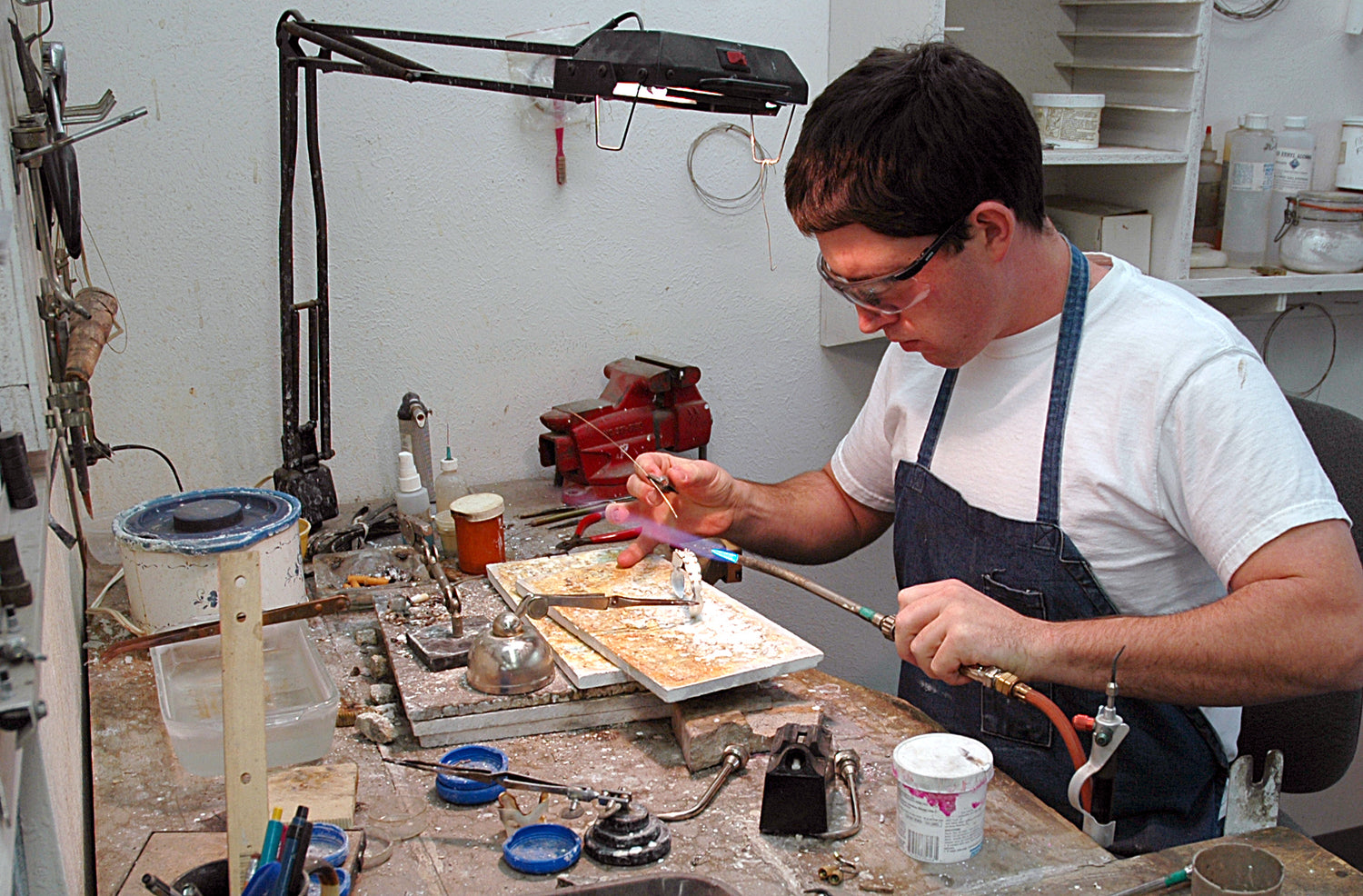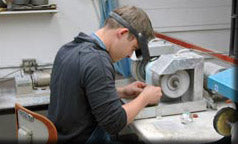Jewelry Care and Cleaning
Tarnish is a product of oxidation, caused by the interaction of silver jewelry with certain elements such as oxygen or sulfur as well as with certain acids. Tarnishing on silver jewelry, when worn on a regular basis, usually does not occur. Storage for a prolonged time causes silver jewelry to tarnish. Contact with rubber bands may cause tarnish - the sulfur in rubber is a catalyst for tarnish. Taking a medication that changes the acidity of your skin may cause silver jewelry to tarnish.
To keep your silver tarnish-free, frequently clean your silver in a mild dishwashing liquid diluted in water. Thoroughly dry your silver jewelry after exposure to water. Store silver in a dry container or a plastic bag with anti-tarnish paper.
To remove tarnish or oxidation film from silver you can use fresh, uncontaminated commercial silver dip liquid, polish paste or polish cloth, available in jewelry supply or hardware stores. Make sure there are no loose stones or parts. Limit the gemstone's exposure to silver cleaners - cleaners may harm certain kinds of gemstones. Please read the cleaning product's instructions before cleaning. Thoroughly rinse jewelry after cleaning, and dry with a soft cloth until it's completely dry.
Gems and precious metals are gifts of nature, which need special care. Even though a gem may be millions of years old, once mined and worn, it is exposed to conditions and chemicals that can damage it.
The harder the gem, the less vulnerable it is to potential damage. A diamond, for example, is the hardest gem known to man, and that's one reason why it is "forever."
Hardness is based on a gem-trade standard called the Mohs Scale, developed in the early 19th century. The scale is structured so that material rated at each higher number can scratch substances with lower numbers. Diamonds are rated the highest, at 10; rubies and sapphires are Mohs 9; emeralds and topaz, 8; and garnets, tourmalines and quartz, 7. Anything softer than a 7 can be scratched with less difficulty, including opal, turquoise, lapis lazuli, coral and pearl.
Gold, silver, and platinum are only Mohs 2-1/2 to 4, which means that they require special care when wearing, storing, or cleaning.
Pure Silver is too soft for most ordinary uses, so, like gold, silver is alloyed, or mixed, with other metals to add hardness and strength. The standard alloy is 92.5% silver and 7.5% of another metal, usually copper. In order for an item to be called sterling, the law requires that it have a minimum silver content of 92.5%. Sterling must be marked as such. There are three approved markings to indicate sterling:
Sterling Silver or Sterling or STR .925 for 92.5%. 999 for 99.9% which is too soft for most jewelry. If one of these three markings is not present on a piece of jewelry, the item is not sterling silver and may not be called such.
Solid Gold is identified by its karate weight such as "10K", "14K" & "18K".
The system of measuring karats is based on a scale of 24, with 100 percent gold equaling 24 karats. Since 24K gold is usually considered too soft for jewelry, the gold in jewelry items is alloyed with other metals to strengthen and harden it. The karat mark tells us the ratio of pure gold to these other metals. A 22K gold piece is 22 parts gold and 2 parts of at least one other metal. An 18K gold piece is 18 parts pure gold and 6 parts other metals.
Note: In the United States the legal minimum standard for what can be considered gold is 10 karats (10 parts gold, 14 parts other metal).
Do's and Don'ts:
DON'T wear fine jewelry when doing housework or gardening.
DON'T heap your jewelry into one drawer. Remember a diamond ring can scratch that pearl necklace. Keep them separate and, ideally, wrapped in velvet, paper, silk or plastic zip-lock bag.
DO let your jeweler check for loose stones frequently.
DO get pearls restrung when the cord begins to fray.
DO clean fine jewelry often to maintain its sparkle and beauty.
DON'T use toothpaste as its abrasives can damage softer gems and metals. Most fine jewelry can be safely cleaned by soaking for 10 minutes in warm soapy water (using a mild detergent soap). Use a soft brush on harder gems to loosen any dirt around the prongs. To reduce greasy build-up on diamond jewelry, dip it in plain alcohol before soaking.
DO store fine jewelry carefully, observing the following guidelines:
DO Store jewelry in a dry place and avoid extremes of temperature and humidity.
DO Keep gemstone-studded jewelry, pearls, and gold and silver pieces separated from each other to prevent scratching. Store fine jewelry pieces in soft pouches, soft cloth wraps or plastic "zip-lock" bags to help protect them.
DON'T overcrowd your jewelry box. Crowding can result in misplaced or lost jewelry if a small piece falls unnoticed from the case. Occasionally, forcing too much jewelry into the box may even bend a fragile piece or chip a delicate stone.
Note: An inappropriate cleaner may actually damage stones or settings.
Household Cleaners: The simplest and safest way to clean any kind of jewelry is to wash it with warm sudsy water. Prepare a small bowl of sudsy water, using any mild liquid detergent and ammonia. Soak the piece a few minutes, and then brush it gently with an eyebrow brush or soft toothbrush while holding it under running water.
Make sure the drain is closed. Some people prefer to place jewelry in wire strainer before holding it under running water. When the piece is clean and sparkling, pat it dry with a soft lint-free cloth or paper towel.
Commercial Cleaning Solutions
Use commercial jewelry cleaners with caution.
Commercial jewelry cleaners are usually no more effective than the household cleaners suggested above, but they are more convenient. They are normally safe for diamonds, rubies, and sapphires, but may be harmful to some gemstones.
Never soak gemstone jewelry in commercial cleaners for more than a few minutes.
Note: Commercial cleaners are not recommended for opal, pearl, coral, lapis lazuli, turquoise and emerald. They may damage or reduce the luster (shine) on these stones.
Ultrasonic Cleaners: Use ultrasonic cleaners for diamonds, rubies, and sapphires only. Ultrasonic cleaners can damage emerald, opal, pearl, and some other colored gemstones.

Wayne DeSantis

Jonas DeSantis


